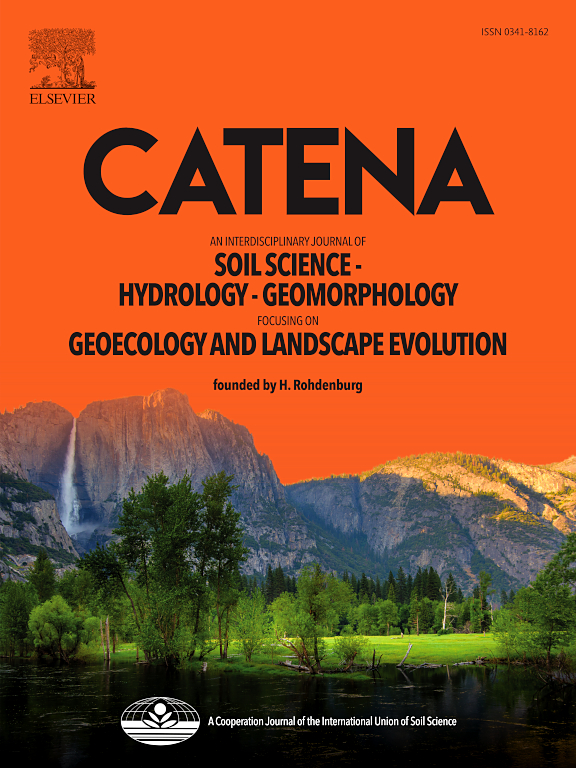综合多种优化策略改进湿地土壤有机碳原位光谱估算
IF 5.4
1区 农林科学
Q1 GEOSCIENCES, MULTIDISCIPLINARY
引用次数: 0
摘要
湿地碳是全球碳循环中陆地碳库的重要组成部分。湿地土壤有机碳(SOC)的准确定量对湿地可持续管理和减缓气候变化至关重要。然而,这一努力往往受到湿地难以进入和与数据获取相关的高经济和劳动力成本的阻碍。可见和近红外(Vis-NIR)光谱学的出现为监测SOC含量提供了一种既省时又经济的方法。利用可见光-近红外光谱技术估算湿地有机碳已经取得了相当大的进展。然而,不同预测策略的性能差异很大,这给使用可见光-近红外光谱估计SOC的方法选择带来了混乱。因此,本研究旨在通过测试和评估240种优化策略,以提高湿地有机碳的原位光谱估计精度,这些优化策略集成了不同的预处理技术、除湿算法、光谱特征选择方法。研究结果表明,最优策略包括一阶导数(1stD)、外部参数正交化(EPO)、改进贪婪特征选择(MFGS)和一维卷积神经网络(1D-CNN)相结合,得到的R2、RPD和RMSE分别为0.94、4.15和1.09 g/kg。在预处理技术方面,1stD优于Savitzky-Golay (SG)和log(1/ R)。EPO成为最佳的除湿算法,有效降低了水分等环境因素的干扰。在光谱特征选择方法中,竞争自适应加权算法(CARS)优于Boruta、MFGS和区间随机蛙(IRF)。在预测模型方面,1D-CNN模型显著优于偏最小二乘回归(PLSR)和随机森林(RF),准确率显著提高(平均R2 = 0.83, RPD = 2.74, RMSE = 1.76 g/kg)。本研究结果可以指导未来的研究选择优化策略,以更准确地通过Vis-NIR光谱估算湿地有机碳。本文章由计算机程序翻译,如有差异,请以英文原文为准。
Improving in-situ spectral estimation of wetland soil organic carbon by integrating multiple optimization strategies
Carbon in wetlands is a critical component of the terrestrial carbon pool in the global carbon cycle. Accurate quantification of wetland soil organic carbon (SOC) is essential for sustainable wetland management and climate change mitigation. However, this effort is often hampered by the inaccessibility of wetlands and high economic and labor costs associated with data acquisition. The advent of visible and near–infrared (Vis-NIR) spectroscopy offers a time- and cost-effective method for monitoring SOC content. Considerable efforts have been directed toward estimating wetland SOC using Vis-NIR spectroscopy. However, great differences were reported for the performance of different predictive strategies, which pose confusion in the choice of methods when using Vis-NIR spectroscopy to estimate SOC. Therefore, this study aims to improve the in-situ spectral estimation accuracy of wetland SOC by testing and evaluating 240 optimization strategies which integrate different pre-treatment technologies, moisture removal algorithms, spectral feature selection methods. Our findings indicate that the optimal strategy involved the combination of first-order derivative (1stD), external parameter orthogonalization (EPO), modified greedy feature selection (MFGS), and one-dimensional convolutional neural network (1D-CNN), yielding R2, RPD, RMSE values of 0.94, 4.15, and 1.09 g/kg, respectively. For pre-treatment technologies, 1stD outperformed Savitzky-Golay (SG) and log(1/reflectance) (Log(1/R)). EPO emerged as the optimal moisture removal algorithm, effectively reducing the interference of moisture and other environmental factors. Among spectral feature selection methods, the competitive adaptive reweighting algorithm (CARS) outperformed Boruta, MFGS, and interval random frog (IRF). In terms of prediction models, the 1D-CNN model significantly outperformed partial least squares regression (PLSR) and random forest (RF), with markedly higher accuracy (averaged R2 = 0.83, RPD = 2.74, RMSE = 1.76 g/kg). Findings from this research could guide future studies in selecting the optimization strategies to more accurately estimate wetland SOC via Vis-NIR spectroscopy.
求助全文
通过发布文献求助,成功后即可免费获取论文全文。
去求助
来源期刊

Catena
环境科学-地球科学综合
CiteScore
10.50
自引率
9.70%
发文量
816
审稿时长
54 days
期刊介绍:
Catena publishes papers describing original field and laboratory investigations and reviews on geoecology and landscape evolution with emphasis on interdisciplinary aspects of soil science, hydrology and geomorphology. It aims to disseminate new knowledge and foster better understanding of the physical environment, of evolutionary sequences that have resulted in past and current landscapes, and of the natural processes that are likely to determine the fate of our terrestrial environment.
Papers within any one of the above topics are welcome provided they are of sufficiently wide interest and relevance.
 求助内容:
求助内容: 应助结果提醒方式:
应助结果提醒方式:


